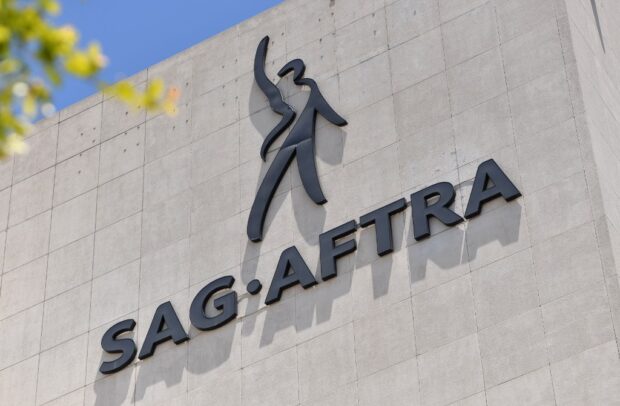
The SAG-AFTRA building, home to the US labor union that represents film and television actors, singers, and other performers, is seen in Los Angeles, California, on July 13, 2023. The union representing striking actors said Nov. 6, 2023, it could not agree to studios’ “last, best and final offer” issued over the weekend in a bid to end a months-long stalemate that has crippled Hollywood. Negotiators for the Screen Actors Guild (SAG-AFTRA) have been mulling the proposal since Nov. 4, as studios seek to halt a damaging stoppage that has brought TV and movie production to a standstill for four months. CHRIS DELMAS / AFP)
LOS ANGELES—The union representing striking actors said Monday, Nov. 6, it could not agree to studios’ “last, best and final offer” issued over the weekend in a bid to end a months-long stalemate that has crippled Hollywood.
Negotiators for the Screen Actors Guild-American Federation of Television and Radio Artists (SAG-AFTRA) have been mulling the proposal since Saturday, as studios seek to halt a damaging stoppage that has brought TV and movie production to a standstill for four months.
In a statement to members posted on social media on Monday, the committee said they were determined to bring the 116-day strike to an end “responsibly,” but had not yet found common ground with the body representing Disney, Netflix, Warner, Universal, Paramount and Sony.
“There are several essential items on which we still do not have an agreement, including (Artificial Intelligence),” the statement said.
“We will keep you informed as events unfold.”
Pressure has been rapidly mounting for a deal. Unemployed actors have increasingly been struggling to make ends meet, and studios already face gaping holes in their release schedules for next year and beyond.
Talks to reach a deal in recent days were attended by studio CEOs, underlining the urgency to end the crisis.
SAG-AFTRA represents some 160,000 performers. Actors below Hollywood’s upper echelons say it has become almost impossible to earn a decent living, as longstanding pay structures have failed to keep pace with inflation and industry changes.
In particular, the growth of streaming platforms—which typically order fewer episodes per series, and pay minimal “residuals” when a hit show gets rewatched—has severely eroded their incomes.
But the use of Artificial Intelligence—particularly the notion that an actor’s likeness could be used long after they have filmed a role—has been a sticking point.
Studios, which have already delayed the release of major films such as “Dune: Part Two” and the next “Mission: Impossible” installment, are eager to restart productions on hit shows like “Stranger Things” in time for next year.
Netflix co-CEO Ted Sarandos told AFP negotiations were still going on.
“We’re at the table and we’re working really hard to get it done,” he said.
“I feel like we’re really close. But you know, these are complicated deals and we’re navigating tricky waters. Our goal is we want to get folks back to work.”
$6.5-billion cost
When SAG-AFTRA walked out in mid-July, Hollywood writers were also on strike.
It was the first time that the two unions had headed to the picket lines simultaneously since 1960, when actor (and future US president) Ronald Reagan led the protests.
But writers struck a deal with studios in September. High-level talks between studios and the actors’ union began soon after.
The overall cost of the industry-wide Hollywood standstill is now estimated to be at least $6.5 billion, mainly from lost wages.
Last week, SAG-AFTRA chief negotiator Duncan Crabtree-Ireland told members he was “cautiously optimistic” after both sides compromised on minimum pay demands, and a bonus structure for starring in hit shows or films.
In previous rounds of talks, studios offered to create strict protections requiring consent and compensation for AI, but the actors’ union argued these did not go far enough.

